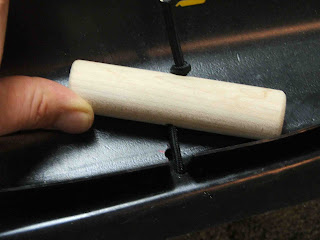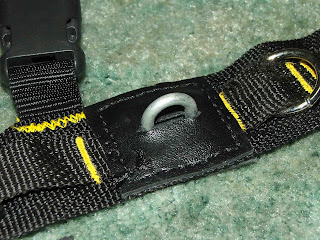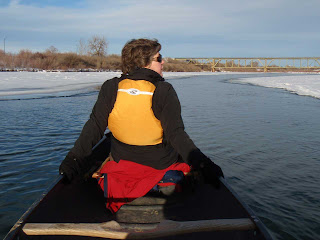
This is the current version of the
pulk that I've been using for the past few years for my back country, winter camping trips. I've found this set up to have a low centre of gravity and pulls straight. The key to a good
pulk is keeping the centre of gravity low. In powder snow
pulks have a tendency to list to one side and in a turn the will quit often turn onto their side making it very difficult to navigate through trees or on tight trails. It's also a pain in the ass to have to constantly unhook yourself in order to right the sled.
I'm often asked, "what is a
pulk". In its simplest form a
pulk is a sled that is fixed to the puller with ridged poles. If the sled is fixed to the puller with rope then it's just a sled.
The first photo shows the
pulk open with the shovel that I use to move snow in camp. It is used to move snow onto the sides of the tent for added warmth, dig pits for kitchens and wind breaks or to create a seat in a snow bank. You can also see my blue foam pad that is used as a sit-upon so my ass doesn't get too cold while sitting in the snow.
I started with two 5 foot children's toboggans from Canadian Tire. I set them together like a clam shell using shock cord as a hinge. This created a long and fairly wide container to carry all my gear. To create a latch I cut slots in the rim of the upper sled and drilled a corresponding hole in the lower sled. A shock cord was fed through the hole and then through a piece of one inch dowel. The dowel is lifted over the rim of the top sled and rests on the bottom of the rim of the, upside down, sled to hold the two together.

In the first photo a yellow rope can be seen woven in a way through the sides of the bottom sled, the two free ends are fed out the front of the
pulk and are as long as the poles. they serve as an emergency system in case the poles fail some how. Believe me it's a good idea to have them in place. On two trips now, the poles have failed due to some pretty hard crashes and the ropes were a life saver. On the end of the rope are
caribiners that serve to attach the rope to the harness.
To attach the poles to the
pulk I used small caster wheels, purchased at Canadian Tire, to create a sort of rotating hinge. I first cut off the rubber wheel then sawed off the axle with a hacksaw. For the connecting poles I used a couple of 5 foot lengths of electrical conduit. 1/4" holes were drilled in either end. One end is attached to the caster hinge via a pin that was purchased at
Peavy Mart. I am working on a design that uses 1/2" fiberglass poles. These will be lighter and more durable than the metal conduit.

A harness was fashioned using the straps from an old backpack. A hip belt was sewed on to help distribute the load evenly on the shoulders and hips. To connect the poles to the harness, a clasp is bolted to the other end of the pole. After having crashed awfully hard a few times I've discovered that these clasps are the weak link in the pole system. This is a good thing because other components like to
pulk itself are spared the force of a hard fall. On the hip belt of the harness the receiving end of a hook and latch for a gate was covered with leather and sewn in place with an awl.



To finish it off I strung up the top with shock cord to create a lashing system to hold down extra gear. It works very well for a pair of skis or a pair of snowshoes.

The only other changes I plan on making are the addition of a latch on the front and back to keep the two shells closed more securely. I've also been toying with the idea of building my own carbon/kevlar shells.
 What a great day! I got up early this morning and went out into the country for some snowshoeing. The snow was deep and powdery and as I made my way in the clearings between the trees three whitetail deer, a doe and two fawns, bounded off. I don't think that they had winded me since the wind was in my face, they must have heard me coming. And to top off a great morning, on the drive home I saw what looked like 6 sharp tail grouse sitting in a tree top. When I got out of the car to get a closer photo they took off and it was then that I realized that there was more than double that number.
What a great day! I got up early this morning and went out into the country for some snowshoeing. The snow was deep and powdery and as I made my way in the clearings between the trees three whitetail deer, a doe and two fawns, bounded off. I don't think that they had winded me since the wind was in my face, they must have heard me coming. And to top off a great morning, on the drive home I saw what looked like 6 sharp tail grouse sitting in a tree top. When I got out of the car to get a closer photo they took off and it was then that I realized that there was more than double that number.

 The sun was warm and the breeze light, and I spent my afternoon on the water with my good friend Ellen. Paddling in the middle of the winter is what most canoeists and kayakers dream about so when the weather turns warm, the river is where you'll find a few dedicated poeple. In Saskatoon we are lucky to have the outflow from the power plant, upstream, from the city which keeps a channel of open water all year round. This winter the current is strong due to higher water levels that normal. As we paddled up stream to the plant a fat beaver was sitting in the snow at the waters eadge enjoying a meal but when he saw us approaching he launched himself into the water. We also saw no fewer than 3 robins. I've heard reports of robins being seen all winter and they certainly do winter over from time to time but this is the first time that I've seen a robin in the dead of winter.
The sun was warm and the breeze light, and I spent my afternoon on the water with my good friend Ellen. Paddling in the middle of the winter is what most canoeists and kayakers dream about so when the weather turns warm, the river is where you'll find a few dedicated poeple. In Saskatoon we are lucky to have the outflow from the power plant, upstream, from the city which keeps a channel of open water all year round. This winter the current is strong due to higher water levels that normal. As we paddled up stream to the plant a fat beaver was sitting in the snow at the waters eadge enjoying a meal but when he saw us approaching he launched himself into the water. We also saw no fewer than 3 robins. I've heard reports of robins being seen all winter and they certainly do winter over from time to time but this is the first time that I've seen a robin in the dead of winter.






